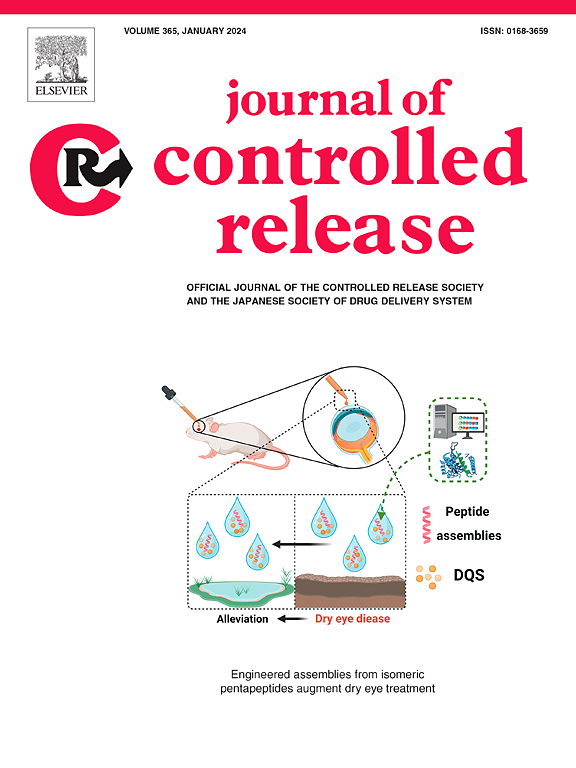用于增强三级淋巴结构形成和癌症免疫治疗效果的注射型水凝胶药物制剂
IF 10.5
1区 医学
Q1 CHEMISTRY, MULTIDISCIPLINARY
引用次数: 0
摘要
肿瘤微环境中的三级淋巴样结构(TLSs)与癌症预后的改善和免疫检查点阻断(ICB)反应的增强有关。在本研究中,开发了一种可注射的基于水凝胶的药物制剂来刺激B16-OVA黑色素瘤小鼠模型中TLSs的形成。一种称为HA-CPP⸦CB (Cabrita et al., 2020[8])的水凝胶是由4-(4-氯苯基)吡啶修饰的透明质酸(HA-CPP)和葫芦[8]脲(CB (Cabrita et al., 2020[8]))之间的超分子相互作用形成的。结果表明,单次注射含有CXCL13趋化因子和LIGHT细胞因子的HA-CPP⸦CB (Cabrita et al., 2020[8])水凝胶可有效增加TLSs密度,促进成熟TLSs形成,抑制肿瘤生长,延长生存期。重要的是,水凝胶处理也上调了次要淋巴器官中抗原特异性t细胞的数量。此外,基于水凝胶的药物制剂与抗pd1 ICB治疗相结合,可以增强肿瘤抑制,提高生存率,并加强TLSs的形成,最终有助于B16-OVA黑色素瘤的根除。总之,本研究证明了水凝胶药物载体作为合成免疫龛支架在B16-OVA黑色素瘤微环境中促进成熟样TLSs形成的潜在应用前景,为推进肿瘤免疫治疗提供了一种有前景的策略。本文章由计算机程序翻译,如有差异,请以英文原文为准。

Injectable hydrogel-based drug formulation for enhancing tertiary lymphoid structure formation and cancer immunotherapy efficacy
Tertiary lymphoid structures (TLSs) in the tumor microenvironment are associated with improved cancer prognosis and enhanced immune checkpoint blockade (ICB) responses. In this study, an injectable hydrogel-based drug formulation is developed to stimulate TLSs formation in a B16-OVA melanoma mouse model. A hydrogel, termed HA-CPP⸦CB (Cabrita et al., 2020 [8]), is formed by supramolecular interactions between 4-(4-chlorophenyl)pyridine modified hyaluronic acid (HA-CPP) and cucurbit [8]uril (CB (Cabrita et al., 2020 [8])). The results reveal that a single injection of HA-CPP⸦CB (Cabrita et al., 2020 [8]) hydrogel containing the CXCL13 chemokine and LIGHT cytokine effectively increases TLSs density, facilitates mature TLSs formation, suppresses tumor growth, and extends survival. Importantly, the hydrogel treatment also up-regulates the number of antigen-specific T-cells in the secondary lymphoid organs. Furthermore, combination of the hydrogel-based drug formulation and the anti-PD1 ICB therapy results in increased tumor suppression, improved survival rates, and strengthened TLSs formation, ultimately contributing to B16-OVA melanoma eradication. In conclusion, this study demonstrates the potential application of hydrogel-based drug carriers as synthetic immune niche scaffolds for promoting mature-like TLSs formation within the B16-OVA melanoma tumor microenvironment, offering a promising strategy for advancing tumor immunotherapy.
求助全文
通过发布文献求助,成功后即可免费获取论文全文。
去求助
来源期刊

Journal of Controlled Release
医学-化学综合
CiteScore
18.50
自引率
5.60%
发文量
700
审稿时长
39 days
期刊介绍:
The Journal of Controlled Release (JCR) proudly serves as the Official Journal of the Controlled Release Society and the Japan Society of Drug Delivery System.
Dedicated to the broad field of delivery science and technology, JCR publishes high-quality research articles covering drug delivery systems and all facets of formulations. This includes the physicochemical and biological properties of drugs, design and characterization of dosage forms, release mechanisms, in vivo testing, and formulation research and development across pharmaceutical, diagnostic, agricultural, environmental, cosmetic, and food industries.
Priority is given to manuscripts that contribute to the fundamental understanding of principles or demonstrate the advantages of novel technologies in terms of safety and efficacy over current clinical standards. JCR strives to be a leading platform for advancements in delivery science and technology.
 求助内容:
求助内容: 应助结果提醒方式:
应助结果提醒方式:


